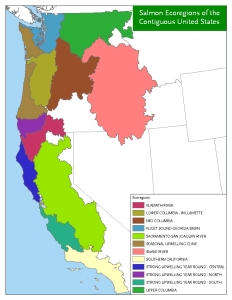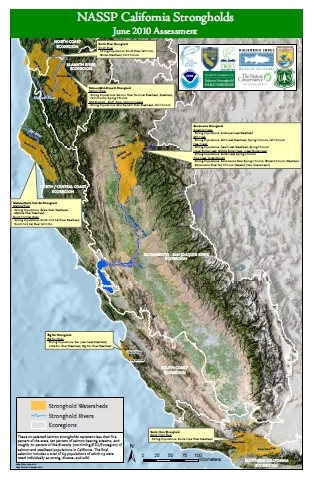Although state and federal programs have invested extensively in watershed restoration efforts and other recovery strategies, to date no listed population of Pacific salmon has been removed from the federal threatened and endangered species list. Unfortunately, the same forces that drove many populations to warrant federal protection continue to threaten those that remain healthy. Accordingly, while recovery efforts must be given time to succeed, a holistic conservation strategy must also include support for preventative approaches that can maintain strong salmon populations and the functioning habitats that they rely on.
The “salmon stronghold approach” is a wild salmon conservation strategy that seeks to complement ongoing salmon recovery efforts by identifying and conserving the healthiest remaining wild salmon populations and the high value habitats they utilize. It recognizes a portfolio of watersheds that supports "wild, diverse, and abundant" salmon populations that make the greatest contribution towards regional conservation goals (for example, those contained in NOAA recovery plans). The approach seeks to increase technical and financial support for the conservation of strongholds and to sustain this support over the long term by integrating strongholds into new and existing policies.
The stronghold approach relies on sound science, effective local and regional planning, and the increased availability of financial and technical resources to support prevention-based strategies in and across stronghold watersheds. Participation in the stronghold effort is voluntary and incentive drive, and the Stronghold Partnership has no regulatory or enforcement authorities.
A salmon stronghold is a portfolio of watersheds that supports “wild, diverse, and abundant” salmon populations that make the greatest contribution towards regional conservation goals (for example, those contained in NOAA recovery plans).
In cooperation with the
North America Salmon Stronghold Partnership and state-based stronghold partnerships,
Wild Salmon Center (WSC) is advancing the stronghold approach through the following steps:
- Implement a science-driven approach to identify core centers of wild salmon abundance and diversity (salmon strongholds);
- Identify and map salmon strongholds, and confer stronghold status to watersheds or groups of watersheds;
- Prioritize prevention-based strategies necessary in and across strongholds, and leverage technical and financial support for implementation; and
- Sustain support by integrating the stronghold approach within new and existing policies and programs.
The
Pacific Salmon Stronghold Conservation Act will establish a new, proactive U.S. policy recognizing the need for conservation of salmon strongholds as a complement to recovery of federally-listed salmon populations. It will also create a grants program to support cooperative conservation efforts that implement locally-led, high value conservation actions in healthy wild salmon ecosystems across Washington, Oregon, Idaho, California, and Alaska.
In April 2009, Senators Maria Cantwell (D-WA), Lisa Murkowski (R-AK), and the entire West Coast Senate delegation introduced
federal legislation to protect and restore the healthiest remaining wild Pacific salmon ecosystems in North America—"Salmon Strongholds." A
companion bill was introduced in the U.S. House on April 22nd by Representatives Mike Thompson (D-CA 1st) and Mike Simpson (R-ID 2nd), with co-sponsorship from members in Washington, Oregon, Idaho, and California.
In June 2009, the House Subcommittee on Insular Affairs, Oceans, and Wildlife held a favorable hearing on the Act. Sara LaBorde (North American Salmon Stronghold Partnership; WA Dept. of Fish and Wildlife), Jack Williams (Trout Unlimited), and Tom Weseloh (California Trout), testified in support of the legislation. The National Marine Fisheries Service's Acting Assistant Administrator and U.S. Fish and Wildlife Service's Director of Fisheries and Habitat Conservation also testified in favor of the salmon stronghold strategy, signaling support from the Obama Administration.
The Subcommittee on Oceans, Atmosphere, Fisheries, and Coast Guard in the Senate Commerce Committee heard testimony on the legislation on April 15, 2010. Guido Rahr, Wild Salmon Center's President & Chief Executive, testified on behalf of the legislation, along with Dr. Gordon Reeves (U.S. Forest Service, Pacific Northwest Research Station), Sara LaBorde (WA Dept. of Fish & Wildlife), and Joe Childress (United Fisherman of Alaska).
In December 2010, during the final week of the last Congressional session, WSC was successful in getting the Pacific Salmon Stronghold Conservation Act included in a natural resources omnibus bill ("America's Great Outdoors Act"), a package of over 100 conservation bills introduced by Senate Majority Leader Harry Reid. Despite broad bipartisan support behind many bills in the package, a blanket hold was placed on all bills with new funding authorizations and programs, effectively preventing passage of the legislation.
In July 2011, Senators Maria Cantwell (D-WA), Lisa Murkowski (R-AK), and the entire West Coast Senate delegation reintroduced the bill.
In November 2011, the Senate Committee on Commerce, Science, and Transportation reviewed the Pacific Salmon Stronghold Conservation Act (S. 1401) and reported the bill out of committee favorably.

Wild Salmon Center is working closely with each of the Pacific salmon bearing states to identify wild salmon strongholds for recognition by the North American Salmon Stronghold Partnership. Strongholds are identified by
ecoregion to ensure that areas of critical genetic and life history diversity are recognized, in addition to those with the greatest abundance.
The stronghold identification methodology uses criteria that are applied consistently across the ecoregions, including the percentage of natural origin spawners, life history diversity, and viability (as indicated by productivity and/or abundance). Each state, which initiates and convenes the process, may choose to augment these criteria with additional decision support tools as needed. The methodology used to identify and map strongholds can be summarized as follows:
- Assess ("score") wild populations within the study area based on three criteria: percent of natural origin spawners, life history diversity, and viability (productivity and/or abundance);
- Identify populations that meet or exceed the threshold for "strong, diverse, and wild";
- Identify and map salmon stronghold design alternatives, based foremost on the strong population data;
- Convene a team of regional conservation partners to review stronghold alternatives and agree upon a recommended set of salmon strongholds; and
- Present the recommended strongholds to the Stronghold Partnership Board for review and approval.
In California, the salmon stronghold designation process is being managed by a team of state, federal, and NGO partners as part of the broader effort underway by the North American Salmon Stronghold Partnership to advance the stronghold approach throughout the Pacific salmon bearing regions of North America.
The
California Stronghold Initiative – Final Report describes the efforts undertaken by the North American Salmon Stronghold Partnership (Stronghold Partnership) in developing the stronghold approach, and California partners in implementing it at the state level. The report is divided into two sections. Section I defines: 1) the “salmon stronghold approach”; 2) the composition, goals, and progress of the Stronghold Partnership; 3) the science of stronghold identification; and 4) the institutionalization of support for prevention-based conservation efforts in and across strongholds. Section II details the implementation of the stronghold approach in California.
Because of inconsistency in population data available across the states and regions occupied by salmon and steelhead, the Stronghold Partnership opted to use an expert opinion survey process to obtain metric ratings for individual populations. This process asked experts to score populations on a scale of 0 to 5 based on individual knowledge of proportion natural origin spawners, viability (as presented by abundance/productivity), and life history diversity. In addition, experts were asked to characterize their level of certainty, also on a 0 to 5 point scale.
 |
Delineation of strongholds is based on spatial and empirical data, decision support tools, and expert judgement. In 2009, the CA Team initiated a formal process to identify the state’s wild salmon strongholds. The methodology used in the identification of California’s six salmon strongholds involved 4 steps:
- Defining ecoregions;
- Population scoring;
- Identifying the “irreplaceable”; and
- Stronghold selection.
The final June 2010 assessment selection of California strongholds is shown in the approved California Stronghold Map. The final selection recognizes those areas that were typically selected as having high conservation value by a decision support tool created for this process; however, there were key decisions made regarding stronghold selection that were beyond the analytical framework of the tool. Additional variables that were considered in the final analysis included:
- Spatial distribution;
- Suitability cost;
- Scale of the planning unit; and
- Protected areas.
Note that stronghold maps are intended to be flexible and iterative, and the identification process should accommodate revisions to the map as new information becomes available and improved analytical approaches are developed. |
A truly effective salmon conservation effort in California requires state, federal, and tribal resource managers along with leading non-governmental agencies to prioritize, coordinate, and fund landscape-scale strategies to conserve the healthiest wild salmon ecosystems. Trout Unlimited prepared an assessment that identifies threats and needs in each of California’s identified strongholds to accomplish this goal. For more information please review the
California Strongholds: Threats and Vulnerabilities Assessment.
The next steps in the stronghold approach following creation of the stronghold map are to:
- Identify both the highest priority prevention strategies necessary to secure the health of strongholds and highlight common systemic challenges faced by local conservation partners; and
- Institutionalize support for prevention-based conservation strategies and those that address broad systemic challenges.
This next phase of the stronghold approach in California will begin with engaging local partners in the stronghold effort by making presentations to the major partnerships active in each stronghold. Presentations will cover the major elements of the stronghold effort, including the science behind stronghold identification, function of the Stronghold Partnership, opportunities presented by stronghold recognition, progress to date, and the purpose and status of the Pacific Salmon Stronghold Conservation Act.